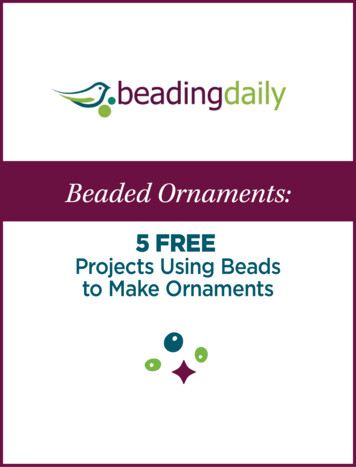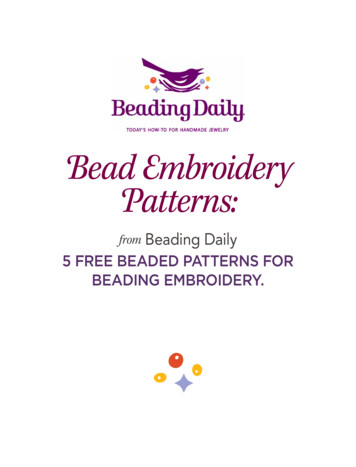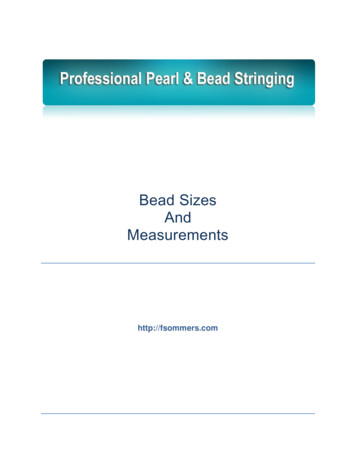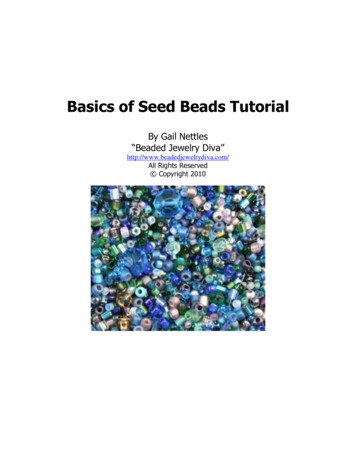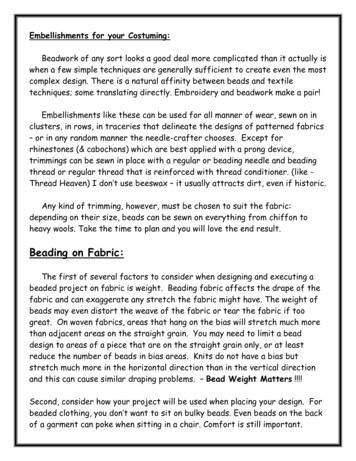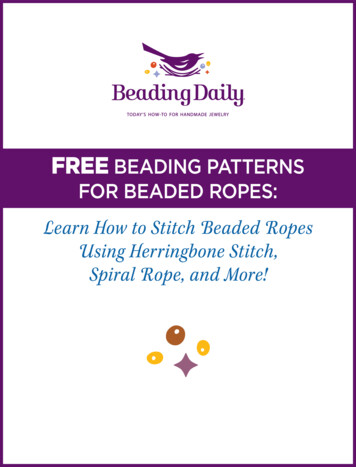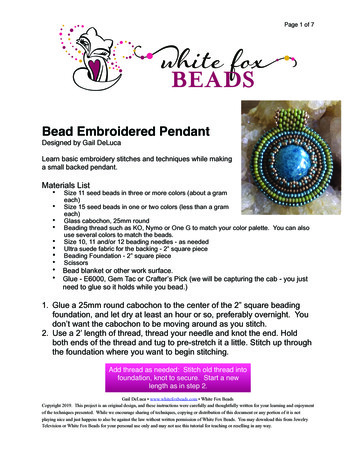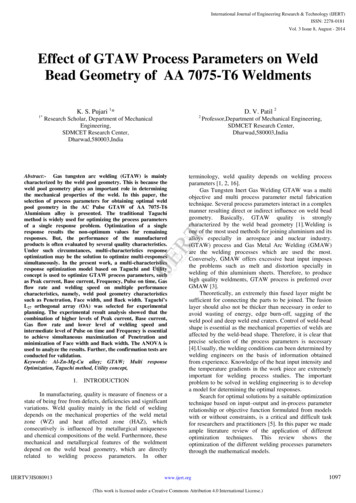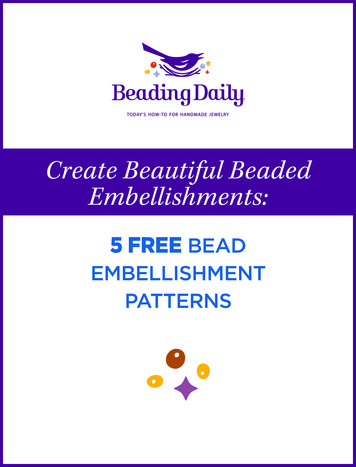
Transcription
Create Beautiful BeadedEmbellishments:5 FREE BEADEMBELLISHMENTPATTERNS
CREATE BEAUTIFULBEADED EMBELLISHMENTS:5 Free Bead Embellishment PatternsMEMENTO MOSAICWRAPPED IN RECTANGLESAUTUMN BRANCH NECKLACEby JEANNE BARTA CRAINE p. 4by EILEEN FELDMAN p. 7by LINDA GETTINGS p. 9EVENING IRIDESCENCEWROUGHT IRONFOR YOUR WRISTby LISA KAN p. 11by JENNIFER VANBENSCHOTEN p. 14TECHNIQUES p. 17 F W MEDIA, INC. ALL RIGHTS RESERVED. F W MEDIA GRANTS PERMISSION FOR ANY OR ALL PAGES IN THIS ISSUE TO BE COPIED FOR PERSONAL USE. BEADINGDAILY.COMpage 2
CREATE BEAUTIFUL BEADED EMBELLISHMENTS:5 Free Bead Embellishment PatternsWhat’s the best way to jazz up your off-loom beadweaving projects? With bead embellishments, of course!Embellishing with beads is a fun way to play with yourdesign skills while learning how to create unique beadedjewelry. And there are so many different techniques thatyou can use for bead embellishing your favorite beadweaving stitches, you’ll never run out of ideas or inspiration. If you love beaded fringe, Linda Gettings’ AutumnBranch Necklace will be a delight for you to stitchup! For beginners, this is the perfect beaded necklaceproject to learn how to create beaded fringe, whilemore experienced beaders can build their design skillsby modifying this beaded necklace project to their owntastes.To help you along, we’ve gathered 5 of our favorite beadembellishment patterns into our latest free eBook, CreateBeautiful Beaded Embellishments: 5 Free Bead EmbellishmentPatterns. These patterns include techniques like basic beadstringing, right-angle weave, and bead embroidery. Areyou ready to dive in and learn how to incorporate beadedembellishments into your bead-weaving and jewelrymaking projects? Right-angle weave is probably my favorite base forplaying with beaded embellishments, and Lisa Kan’sEvening Iridescence bracelet is the perfect example ofwhy I love this technique so much. A few simple beadembellishments turn a simple bracelet into somethingworthy of a night on the town! Use basic bead embroidery techniques to embellishyour favorite keepsake beads and treasures whenyou stitch up Jeanne Barta Craine’s Memento Mosaicbracelet. Each little “bead picture” can be embellishedas much or as little as you like, finished with an easypicot trim. Basic gemstone bead frames are turned intominiature works of art in Eileen Feldman’s Wrapped inRectangles beaded bracelet making project. Use basicstringing and easy beaded fringe techniques to makeeach one a masterpiece. Finally, my very own Wrought Iron for Your Wristbracelet was inspired by a decorative iron fence Isaw on a walk one afternoon. Using bugle beads forthe base of right-angle weave means that this beadembellished bracelet works up quickly!Beaded embellishments are what keep our beadingprojects interesting! You can learn so much from workingthem into your own designs and ideas. No beadworkneed be boring when you have such a range of beadembellishment techniques to choose from. Just work upa sample of your favorite beading stitch, pick a beadedembellishment technique (or two, or three!) and startstitching.Bead Happy,Learn How to String Beads: 5 Free Patterns for Stringing Beadseditor, beadingdaily JENNIFER VANBENSCHOTENproduction designer JANICE TAPIA / photography JOE COCA, ANN SWANSONProjects and information are for inspiration and personal use only. BeadingDaily, Beadwork, and Stringing do not recommend, approve, or endorse any of theadvertisers, products, services, or views advertised in this publication. Nor do BeadingDaily, Beadwork, or Stringing evaluate the advertisers’ claims in any way. Youshould, therefore, use your own judgment in evaluating the advertisers, products, services, and views advertised in BeadingDaily, Beadwork, and Stringing. F W MEDIA, INC. ALL RIGHTS RESERVED. F W MEDIA GRANTS PERMISSION FOR ANY OR ALL PAGES IN THIS ISSUE TO BE COPIED FOR PERSONAL USE. BEADINGDAILY.COMpage 3
memento mosaicJEANNE BARTA CRAINECreate tiny treasures by embellishingflat beads or buttons. Link themtogether for a sensational, personalizedbracelet that is truly unique to you.TECHNIQUES:: backstitch beadembroidery:: peyote stitch:: right-angle weave:: picot F W MEDIA, INC. ALL RIGHTS RESERVED. F W MEDIA GRANTS PERMISSION FOR ANY OR ALL PAGES IN THIS ISSUE TO BE COPIED FOR PERSONAL USE. BEADINGDAILY.COMpage 4
MATERIALS1) FOCAL. Tie a knot at one end of 5' ofconditioned thread; place a needle at theother end. Center one of the flat focalbeads or buttons on 1 piece of beadingfoundation. Pass through the foundationfrom back to front near the bead’s hole orthe button’s shank. Pass through the beador button shank and sew down throughthe foundation, securing the item inplace. Repeat the thread path several timesto secure. Knot the thread but do nottrim. Exit up through the fabric next tothe edge of the focal bead/button.Fig. 2: Peyote-stitching Rounds 1 and 23) BACKING. Trim the foundationclose to the edge of the beadwork, takingcare to avoid cutting any stitches or theworking thread. Center the focal on1 piece of Ultrasuede with wrong sidestogether. Trim the Ultrasuede even withthe outline of the base round, beingcareful not to cut threads.2) BEZEL. Use bead embroidery andpeyote stitch to form a bezel around thefocal bead/button:Base: String 3 size 8 s, lay them along theedge of the focal, and pass downthrough the foundation. Pass upthrough the foundation between thefirst and second bead just added andpass through the second and thirdbead. String 2 size 8 s, lay them alongthe edge of the focal, pass downthrough the foundation, pass upthrough the foundation between the2 beads just added, and through thelast bead added (Fig. 1); repeat, workingbackstitch bead embroidery around toencircle the focal. Make sure you’veused an even number of beads if youwant to build up the bezel around thefocal in the next rounds.4) PICOT EDGING. Use the beadwork’sworking thread to pass through the edgeof the Ultrasuede and make a small stitchsecuring the foundation and Ultrasuedetogether with wrong sides together.String 3 size 11 s; pass through the beading foundation from front to back andthe Ultrasuede from back to front onebead’s width away. Pass back through thelast size 11 just added to form a picot.*String 2 seed beads; pass through theedge of the beading foundation fromfront to back and the Ultrasuede fromback to front one bead width’s away fromthe last stitch; pass back through the second bead just strung (Fig. 3). Repeat from* to connect the focal to the UltrasuedeFig. 1: Working backstitch bead embroideryExiting one of the base beads,work tubular peyote stitch off the baseusing 1 size 8 in each stitch. Step upfor the next round by passing throughthe first bead of this round.Round 2: Work tubular peyote stitch using1 size 11 in each stitch (Fig. 2). Weavethrough beads to exit down through thebeading foundation. Make several smallstitches at the back of the foundation tosecure the thread; knot and trim.Round 1:Fig. 3: Joining the foundation and Ultrasuedewith picot edgingwhile adding a picot edging. When working the last stitch, string 1 size 11 andpass back down through the first beadadded and the foundation and Ultrasuede. This completes the first component. Don’t trim the thread; set thecomponent aside.Repeat Steps 1–4 four times for a total of10 g total assorted size 11 and 8 Japaneseseed beads in blue, turquoise, indigo,chartreuse, green, fuchsia, gunmetal,copper, and bronze2 size 6 Japanese seed beads in bronzeand purple7 bronze 6mm faceted bugle beads2 copper 2.5mm faceted tubes2 fuchsia 6mm textured vintage sequins5 assorted 12–16mm flat round or rectanglebeads or buttons in purple, blue, fuchsia,and orange1 antique copper 16mm toggle clasp6 brown or black 2 2" pieces of beadingfoundation6 black 2 2" pieces of UltrasuedeBlack size D beading thread or smoke 6 lbbraided beading threadThread conditionerTOOLSScissorsSize 10 beading needleFINISHED SIZE: 8"5 components using the remaining focalbeads/buttons and changing the seedbead colors and sizes as desired so thateach component is unique. Note: If youdo not wish to bezel some of the flatbeads/buttons, consider bead-embroidering circles around the beads as youdid in the base round.5) STITCHED COMPONENT. Form a12 22mm component with embroideryonly instead of stitching on a focal bead/button as before: Use backstitch beadembroidery to attach bugles and size 11 sto the center of a 2 2" piece of beadingfoundation, following the layout of Fig. 4.To add fringe, exit between beads nearone corner of thefocal, string 1 sequin and 1 size 11 ,and pass backthrough the sequinand foundation toform a fringe; repeat to add a matching fringe in theopposite corner ofthe focal. Repeat Fig. 4: Pattern for thestitched focal F W MEDIA, INC. ALL RIGHTS RESERVED. F W MEDIA GRANTS PERMISSION FOR ANY OR ALL PAGES IN THIS ISSUE TO BE COPIED FOR PERSONAL USE. BEADINGDAILY.COMpage 5
ARTIST’S TIPS The designer likes to use black orbrown Stiffened Easy Felt or Lacy’sStiff Stuff for the embroideredfoundation; its dark color helpsthe foundation visually recedeinto the background.Steps 3 and 4 to back and edge thestitched component. Set aside.6) LINKS. Line up all the components ina pleasing order and connect them byworking a single unit of right-angleweave and/or peyote stitch:Right-angle-weave link: Weave the workingthread of one component to exit fromthe tip of one picot on the edge. String1 size 11 ; pass down through the tip ofa picot on the edge of a second component. String 1 size 11 ; pass downthrough the tip of the next picot on thesecond component. String 1 size 11 ; This is a great portable projectto bead on the go since you canwork on one focal at a time andstill have a great feeling ofaccomplishment.pass up through the bead at the tip of apicot on the first component. String1 size 11 ; pass up through the firstbead exited in this section (Fig. 5).Repeat the thread path to reinforce. Ifdesired, embellish the link by stitching1 copper tube bead to the center of theunit. Secure the thread and trim.Peyote-stitch link: Weave the workingthread of one component to exit fromthe tip of one picot on the edge. Worka strip of peyote stitch 4 size 11 s wideby 4 rows long off the last picot beadexited and the tip bead of the nearestpicot (Fig. 6a). Interlock the up beads ofthe fourth peyote-stitched row with the If you’d like to use a smallcabochon instead of a beador button, use two-part epoxyto glue it to the beadingfoundation in Step 1.Fig. 7: Attaching one half of the claspand pass through the tip bead of the following picot (Fig. 7). Repeat the threadpath to reinforce; secure the thread andtrim. Begin a new thread at the other endof the bracelet and repeat entire step to attach the other half of the clasp. Note: Ifdesired, you may attach the clasp to beadsof the focal’s base-round embroideryinstead of the picots. baFig. 5: Linking 2 components with a single unitof right-angle weaveFig. 6: Linking 2 components with peyote stitchtip beads of 2 picots on another component, lacing them like a zipper(Fig. 6b). Repeat the thread path toreinforce; secure the thread and trim.adetilThe back of the braceletshowing a peyote-stitch link7) CLASP. Weave one of the remainingworking threads to the end of the bracelet and exit the tip of one picot at theedge. String 3 size 11 s, 1 size 6 , 3 size11 s, one half of the clasp, and 3 size 11 s.Pass back through the size 6 and string3 size 11 s, skip one picot on the edge,JEANNE BARTA CRAINE lives in Cedar Rapids,Iowa, where she specializes in improvisational artjewelry. She has been beadweaving for aboutfifteen years and enjoys teaching and sharing withothers at Bead Haven in Cedar Rapids. ContactJeanne at jbartacraine@hotmail.com.RESOURCESCheck your local bead shop or contact:FireLine braided beading thread and Nymonylon beading thread, Stiffened Easy Felt, andall beads and findings: Bead Haven, (319)247-2323, www.beadhavenbeads.com. F W MEDIA, INC. ALL RIGHTS RESERVED. F W MEDIA GRANTS PERMISSION FOR ANY OR ALL PAGES IN THIS ISSUE TO BE COPIED FOR PERSONAL USE. BEADINGDAILY.COMpage 6
techniques stringing crimping fringeWrapped in RectanglesEileen FeldmanWhen Eileen found some amber rectangles, all she could see were little picture frameswaiting for artwork. The materials used in the bracelet all jumped together with colorand texture. How lovely to have five little works of art in one bracelet! F W MEDIA, INC. ALL RIGHTS RESERVED. F W MEDIA GRANTS PERMISSION FOR ANY OR ALL PAGES IN THIS ISSUE TO BE COPIED FOR PERSONAL USE. BEADINGDAILY.COMpage 7
FINISHED SIZE 8 1 2"Materials2 g copper size 11 seed beads1 g green size 11 seed beads28 black size 6 seed beads2 copper size 6 seed beads3 clear 3mm crystal bicones13 total 6–13mm accent beadsin black crystal, amber glass, carnelian,and peridot10 total 11 6mm pressed-glass leavesin amber, clear, and copper5 red agate 24 34mm rectangle beadframes20 Bali silver 2mm cubes1: Base. Use the wire to string 1 crimp tube,1 copper size 6 , and one half of the clasp; passback through the bead and crimp tube andcrimp. String 1 black size 6 , one side of 1 rectangle, 2–3 black, 2 leaves, 2–3 black, the otherside of the rectangle, and 1 coil spacer; repeatfour times, omitting the last spacer. String1 black, 1 crimp tube, 1 copper size 6 , andthe other half of the clasp; pass back throughthe copper size 6 and crimp tube and crimp.2: Embellishments. Use an overhand knot tosecure 5' of thread to the wire between thecrimp tube and first black size 6 .Branch fringes: Pass through 1 black. String6 copper size 11 s and 1 cube; pass backthrough the last 4 copper. String 4 copperand 1 cube; pass back through the 4 copperjust strung and the first 2 copper. Passthrough the first black again to center thefringe over the bead; continue passingthrough beads to exit from the next black(Figure 1). Repeat entire step to workanother branch fringe and pass through thenext black.Tips5 silver 3mm daisy spacers4 Bali silver 8 3mm coil spacers1 silver 22mm crown-and-sceptertoggle clasp2 silver 2mm crimp tubesBlack size D beading threadG-S Hypo Cement12" of silver .024 beading wireDon’t be afraid to experiment with beadframes other than the ones shown here.Simply adjust the number of black size 6 beads needed to fill the center of theframes in Step 1 and embellish as desired.ToolsSize 10 beading needleScissorsWire cuttersCrimping pliersAccent fringe: String 1 accent bead, 1 smallspacer, and 1 bicone or 1 size 11 ; pass backthrough the spacer and accent bead. Passthrough the black again to center the fringeover the bead (Figure 2).Figure 2Leaf loops: Pass through the next leaf. String4 copper size 11 s and pass through the leafagain. Pass through the next leaf and repeatto make a second loop (Figure 3).Figure 3Eileen Feldman is a self-taught jewelry devotee with apreordained heart of an artist-of-all-trades. She has a richcreative history that includes jewelry design, mosaics,needlepoint, and knitting. Her love of beads and baublesFigure 1Continue working embellishments for thelength of the bracelet, with 1 branch fringeover the last black bead outside of the frame.Secure the tail threads, trim, and dab the knotswith glue.has spurred her never-ending creativity.RESOURCESCheck your local bead shop or contact: Clasp: CarlClasmeyer, (505) 989-5711, www.clasmeyer.com. F W MEDIA, INC. ALL RIGHTS RESERVED. F W MEDIA GRANTS PERMISSION FOR ANY OR ALL PAGES IN THIS ISSUE TO BE COPIED FOR PERSONAL USE. BEADINGDAILY.COMpage 8
Autumn Branch NecklaceLinda GettingsPeyote-stitched bead tubes are strung between round beads creating the “trunk” of this necklace whilean effusion of fringe creates the “branches.” Although the color and shape of the necklace make itreminiscent of a tree in fall, this unique piece is seasonless in its appeal. F W MEDIA, INC. ALL RIGHTS RESERVED. F W MEDIA GRANTS PERMISSION FOR ANY OR ALL PAGES IN THIS ISSUE TO BE COPIED FOR PERSONAL USE. BEADINGDAILY.COMpage 9Autumn Branch.indd 3010/4/11 1:25 PM
MaterialsNotions15 g size 11 seed beads15 g size 2 bugle beads50–100 round 6mm beadsPowerPro beading threadThread Heaven or beeswaxSize 10 beading needleScissorsTe c h n i q u e sTension bead, flat peyote stitch, stringing, fringeF i n i s h e d S i z e 27"Beaded tuBesStep 1: Using 6' of thread, string a tension bead leaving a 5"tail. String 11 2" of seed beads, ending with an even number of them. * String 1 seed bead and pass back throughthe second-to-last bead. String 1 bead, skip a bead, andpass back through the next bead. Repeat, working peyote stitch down the row of beads, then repeat from * fora total of 9 rows. Roll the beads into a tube and stitchthrough the first and last rows to join the ends like azipper (Figure 1). Work the threads into the beadwork,tying knots between beads, and trim close to the work.Repeat Step 1 to make nine tubes.stringingStep 2: Secure the ends of a 48" piece of doubled threadinside one of the tubes. String one 6mm and one beadedtube. Repeat for all the tubes. String one 6mm and 2seed beads 30 times. String one 6mm and pass throughthe end of the first tube. Secure the thread in thebeadwork and trim close to the work.FringeStep 3: Using 5' of thread, secure the end inside the top of thefourth tube, exiting at the edge. String 2 or 3 seed beads,Tips Always use a few seed beads before you add“sticks” to the main branches. Doing so will give thesticks more flexibility and movement. To make a bracelet, crimp one half of a clasp tothe end of 8" of beading wire. String one 6mm and 2seed beads for 3", then string a 14mm square bead.String one 6mm and 2 seed beads for 3” and crimpon the other half of the clasp. Begin a thread at oneend of the bracelet and work short branches offringe all along its length, passing through the corestrand of beads.Figure 1Figure 2l bugle, l seed bead, l bugle, and another seed bead.* Skipping the last bead strung, pass back through thelast bugle and next seed bead. String 1 seed bead, lbugle, and 1 seed bead. Repeat from * once more andthen pass through 2 beads of the tube. Continue adding“branches,” increasing the length of the initial strand ofbeads and adding a 6mm every few branches (Figure 2).Work along the bottom of the tubes, increasing thelength of your branches to the center of the necklace,then decreasing as you finish the second half. (Linda Gettings lives in CenterVa l ley, Pennsylvania, andteaches classes at My Father’sBeads in Coopersburg, Pennsylvania; Beadfest in Ft. Washington, Pennsylvania; and at theBerks Bead Bazaar in Reading,Pennsylvania. She can bereached at ladybeading@aol.com and her work can be seenat www.bead generation.com.Companion bracelet. F W MEDIA, INC. ALL RIGHTS RESERVED. F W MEDIA GRANTS PERMISSION FOR ANY OR ALL PAGES IN THIS ISSUE TO BE COPIED FOR PERSONAL USE. BEADINGDAILY.COMpage 10
evening iridescenceLISA KANElaborate embellishments atop a baseof chevron chain and right-angle weaveperfectly complement the clasp that cleverlydoubles as a focal piece.TECHNIQUESright-angle weavefringechevron chainpicotoopti::::::::For a softerlook, work inhues of pink,peach, andmauve.n F W MEDIA, INC. ALL RIGHTS RESERVED. F W MEDIA GRANTS PERMISSION FOR ANY OR ALL PAGES IN THIS ISSUE TO BE COPIED FOR PERSONAL USE. BEADINGDAILY.COMpage 11BW Evening Iridescence.indd 741016200811103910/16/08 11:09:19 AM
MATERIALS1) CHEVRON CHAIN. Wrap half of 12'of thread around the bobbin (this reduces the necessity to add thread toooften). Use size 11 s to stitch a base usingchevron chain and right-angle weave:Unit 1: String 1 midnight, 2 teal, 1 midnight, 3 teal, 1 midnight, and 2 teal;pass back through the first bead strungto form a chevron unit.Unit 2: String 3 teal, 1 midnight, and2 teal; pass back through the thirdmidnight bead added in Unit 1 (Fig. 1).Fig. 1: Units 1 and 2of the chevron chainString 3 teal, 1 midnight, and2 teal; pass back through the midnightbead added in the previous unit.Units 4–48: Repeat Unit 3 to form a chain48 units long or long enough to fitsnugly around your wrist, minus thelength of the clasp. Note: If adjustingthe length, be sure to end with an evennumber of units.Unit 3:6 teal just strung, and the following setof 3 teal on the edge of the chevronchain (Fig. 3).Fig. 3: Unit 2 of one right-angle-weave sideContinue workingright-angle-weave units, with 3 teal oneach side, to the end of the chevronchain. Do not trim the thread.Side 2: Unwind the bobbin and place aneedle on the thread. Repeat entirestep on the other side of the chevronchain.Side 1, Units 3–24:3) GAPS. Use Side 2’s working thread tostitch 1 midnight-size 15 between eachcorner gap of each of the right-angleweave units (Fig. 4).4 g fuchsia-lined light sapphire size 15 Japanese seed beads3 g green iris size 15 Japanese seed beads2 g midnight iris size 15 Japanese seedbeads8 g teal iris size 11 Japanese seed beads2 g fuchsia-lined amethyst size 11 Japaneseseed beads2 g midnight iris size 11 Japanese seedbeads3 g fuchsia-lined light sapphire size 8 Japanese hex beads28 metallic sage 4–5 2mm center-drilledkeishi pearls96 green 2mm seed pearls54 light peacock 3 4mm rondelle pearls1 sterling silver 18 17mm 2-strand box claspwith ribbed matte glass inlaySmoke 6 lb braided beading threadTOOLS2 size 12 beading needlesScissorsNo Tangle thread bobbinFINISHED SIZE: 6½"Fig. 5: Attachingthe clasp2) RIGHT-ANGLE-WEAVE SIDES. Usesize 11 s to work right-angle weave off thechevron chain:Side 1, Unit 1: Weave through beads to exitfrom the first teal of the 3-bead set inthe second-to-last chevron unit.String 9 teal; pass through the 3 teallast exited and the first 3 beads juststrung to form a right-angle-weaveunit (Fig. 2).Fig. 2: Unit 1 of oneright-angle-weave sideString 6 teal; pass backthrough the next set of 3 teal on theedge of the chevron chain, the 3 nearest side beads of the previous unit,Side 1, Unit 2:Weave through beadsto exit the nearest midnight size 11 ofthe chevron chain. String 3 teal; passthrough the fourth green iris added tothe nearest clasp loop. String 3 teal;pass back through the fourth green irisadded to the second clasp loop, to linkthe loops. String 3 teal; pass throughthe midnight size 11 added in the lastunit of the chevron chain (Fig. 6).Loop reinforcements:Fig. 4: Filling the gaps with size 15 s4) CLASP. Make seed-bead loops toconnect each half of the clasp:Loop 1: Weave through beads to exit fromthe center teal of a right-angle-weaveunit at one end of the base. String1 teal, 7 green iris, and one loop of onehalf of the clasp; pass back through theteal just strung and through the beadlast exited on the base. Repeat thethread path to reinforce.Loop 2: Weave through beads to exit fromthe center bead of the other rightangle-weave unit at the same end ofthe base. Repeat Loop 1 to connect thesecond clasp loop (Fig. 5).Fig. 6: Reinforcingthe clasp F W MEDIA, INC. ALL RIGHTS RESERVED. F W MEDIA GRANTS PERMISSION FOR ANY OR ALL PAGES IN THIS ISSUE TO BE COPIED FOR PERSONAL USE. BEADINGDAILY.COMpage 12
ARTIST’S TIPSThis bracelet is designed to be wornwith the clasp on top of your wrist asthe focal piece—a great way to showcase your favorite clasp.Weave through beadsto exit from the second loop-reinforcement bead. *String 1 green iris,1 rondelle pearl, and 3 fuchsia-linedsize 15 s; pass back through the pearl.String 1 green iris; pass through theloop-reinforcement bead last exited toform a fringe.* Weave through beadsto exit the fifth reinforcement bead.String 3 fuchsia-lined size 15 s; passthrough the green iris last exited againto form a loop. String 1 keishi and1 fuchsia-lined size 11 ; pass backthrough the keishi and through thegreen iris last exited to form a fringe.Weave through beads to exit from thesecond-to-last loop reinforcementbead. Repeat from * to * for a secondbutton-pearl fringe that mirrors thefirst.Repeat entire step at the other end of thebase to attach the second half of the clasp.Loop embellishments:5) EDGES. Use seed beads and pearls toembellish the base edges:Fringe: Weave through beads to exit froma midnight size 15 gap bead at theoutside corner at one end of the base.String 1 green iris, 1 rondelle pearl,and 3 fuchsia-lined size 15 s; passback through the pearl. String 1 greeniris; pass through the midnight size15 last exited and the next 2 tealalong the base edge.Picots: String 3 fuchsia-lined size 15 s;pass through the teal just exited again,the next teal, and the following size15 . Continue, forming fringes at eachFig. 7: Adding picots to the sidesKeep your chain-nose pliers closeat hand. They are great for helpingweave the needle through tight spotsand straightening bent needles.size 15 along the base edge and thepicots between (Fig. 7).Repeat entire step on the other base edge.6) CHEVRON ZIGZAGS. Weavethrough beads to exit from a non-fringeteal at the outside corner at one end ofthe base. String 1 seed pearl, 1 hex, and1 seed pearl; pass through the teal at theopposite corner and the next 2 beads,exiting from the unit’s adjacent corner(Fig. 8). Continue in this zigzag pattern toIf you have trouble finding2mm seed pearls, size 15 seedbeads can be used instead.abFig. 9: Adding keishi fringe and picotsContinue adding keishi fringe and picotsfor the length of the base and then addalternating embellishments to the otherside of the chevron chain. Secure threadand trim. Fig. 8: Embellishing the right-angle-weave unitsAnother colorway inpurples and mauveembellish each right-angle-weave unit.Making sure the hex strands cross overthe units at an angle opposite the firstside to create a chevron effect, embellishthe units on the other edge of the base.7) PEARLY PATH. Working at one endof the base, weave through beads to exitfrom the center teal in the 3-bead setthat makes up the common wall betweenthe first chevron and right-angle-weaveunits. Add fringe and picots using keishipearls and size 15 s:Keishi fringe: String 1 keishi pearl and1 fuchsia-lined size 11 ; pass backthrough the keishi pearl and throughthe teal last exited to form a fringe(Fig. 9a). Weave through beads to exitfrom the center teal of the next3-bead set.Picots: String 3 fuchsia-lined size 15 s;pass through the teal last exited tomake a picot (Fig. 9b). Weave throughbeads to exit from the center teal of thenext 3-bead set.Bead and glass artist LISA KAN draws her inspiration from nature, ceramics, Japanese arts andaesthetics, and Victorian-era jewelry. She is a frequent contributor to Beadwork, Stringing, and otherpublications and the author of Bead Romantique(Interweave, 2008). Visit her website, www.lisakan.com.RESOURCESCheck your local bead shop or contact:Keishi pearls: East West Best Trading Co.,(415) 504-7138, www.eastwestbest.net.Rondelle and seed pearls: Evergreen TradingCo., (213) 688-2723. Clasp: Claspon-Claspoff,Division of Bead Need, (954) 880-0880,www.claspon-claspoff.com. Seed beads: SanGabriel Bead Co., (626) 447-7753, www.beadcompany.com. FireLine braided beadingthread: (800) BASS-PRO, www.basspro.com. F W MEDIA, INC. ALL RIGHTS RESERVED. F W MEDIA GRANTS PERMISSION FOR ANY OR ALL PAGES IN THIS ISSUE TO BE COPIED FOR PERSONAL USE. BEADINGDAILY.COMpage 13
projectbeadweavingWrought Ironfor Your WristJENNIFER VanBENSCHOTENMake a geometric framework of “windows” withbugle beads and add a nifty little twist of seed beads,for a bracelet with the look of an Art Deco gardengate. Create the bugle windows first, then stitch the“wrought iron” crisscrosses of seed beads.advanced beginnerWHAT YOU NEED 1 g opaque black size 11 Japanese seed beads 10 g metallic bronze 8mm bugle beads Black Nymo or WildFire .006 beading thread Size 10 or 12 needle Scissors G-S Hypo Cement F W MEDIA, INC. ALL RIGHTS RESERVED. F W MEDIA GRANTS PERMISSION FOR ANY OR ALL PAGES IN THIS ISSUE TO BE COPIED FOR PERSONAL USE. BEADINGDAILY.COMpage 14
Stitch the framework1. Thread a needle on a 5’ piece of Nymo. 3.String 2 bugle beads. Pass back throughthe first bugle bead. Pull thread gently butsnugly so the 2 bugle beads line up next toeach other.String beads in the following order:1 seed bead, 1 bugle bead, 1 seed bead,1 bugle bead, 1 seed bead, 1 bugle bead, and1 seed bead. Pass through the second buglebead and pull gently to form a square. Passback through the first 2 bugle beads strungin Step 3.5. Repeat Steps 3 and 4 until you have atotal of 11 “frames.”Embellish the frames6. Pass back through thebeadwork sothe needle exits the top bugle bead of theeleventh frame.4. String 1 bugle bead and pass backthrough the second bugle bead strung inStep 3. Pull thread gently but snugly sothat the 2 bugle beads line up next to eachother. Repeat Step 2 to form 2 picots on thetop and bottom of these 2 bugle beads.7.String 9 seed beads. Pass through thebugle bead on the bottom of the frameso that the beads run in a diagonal acrossthe frame.2. String 3 seed beads. Pass back throughthe second bugle bead, forming a picot.String 3 seed beads and pass back throughthe first bugle bead, forming a picot.8. String 16 seed beads. Push the seedbeads up against the bugle bead and verycarefully wrap the strand of seed beadsunder, around, then over, the diagonalbeads across the frame.9. Pass through the top bugle bead thatyou originally exited (needle will exit in thesame direction as in Step 1). F W MEDIA, INC. ALL RIGHTS RESERVED. F W MEDIA GRANTS PERMISSION FOR ANY OR ALL PAGES IN THIS ISSUE TO BE COPIED FOR PERSONAL USE. BEADINGDAILY.COMpage 15
10. Pass back through the beadwork sothe needle exits from the top bugle bead ofthe second frame.Bugle beads can have sharp ends. Use an emery board to file any burrs.15.Pass back through the first seedbugle-seed bead combination strung. Pullgently but snugly so that the 2 rows ofbugle beads and seed beads line up next toeach other. Remove the stop bead.18. With the working thread, pass throughthe bugles to exit a middle seed bead.16.Continue to work in
embellishment patterns into our latest free eBook, Create Beautiful Beaded Embellishments: 5 Free Bead Embellishment Patterns. These patterns include techniques like basic bead stringing, right-angle weave, and bead embroidery. Are you ready to dive in and learn how to incorporate beaded embellishments into your bead-weaving and jewelry-
